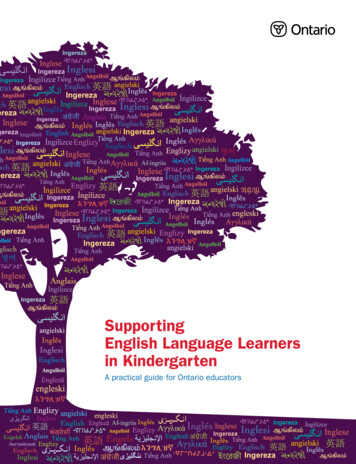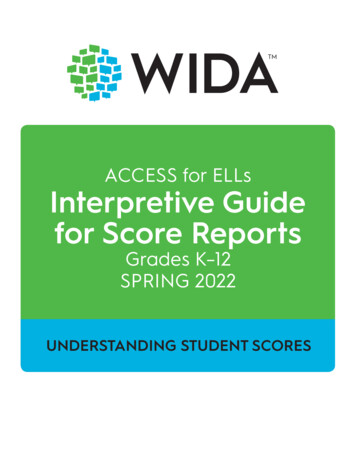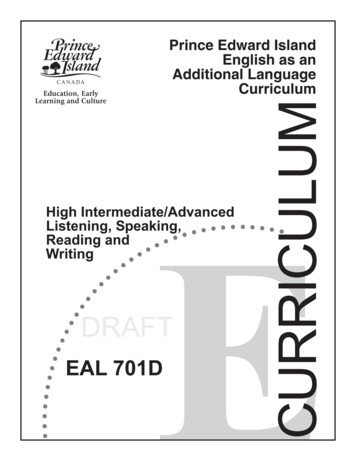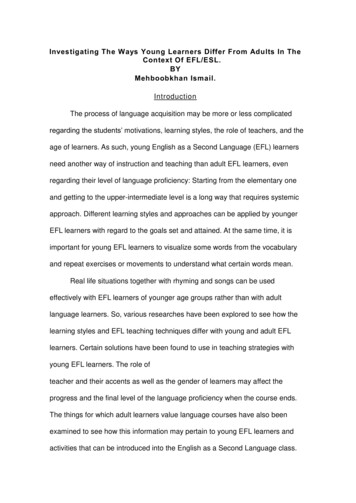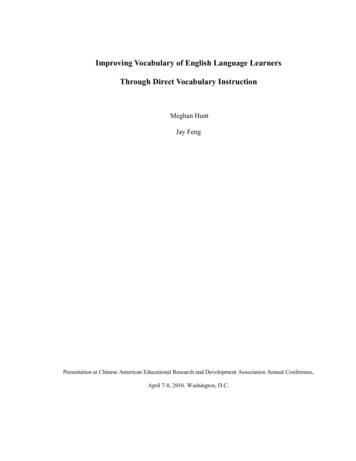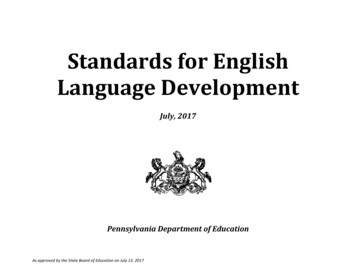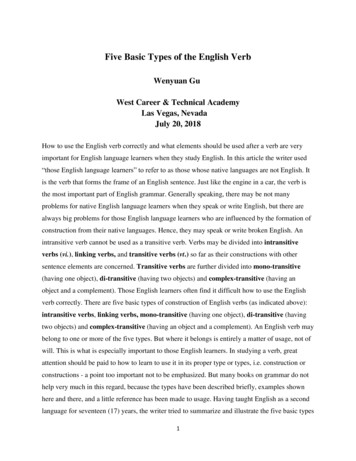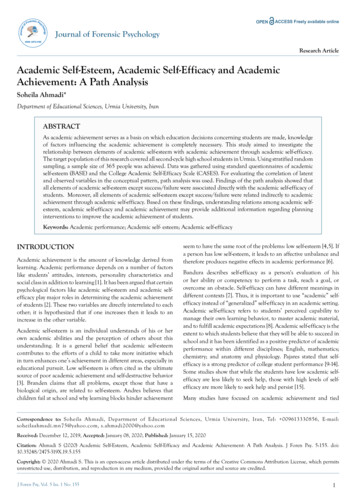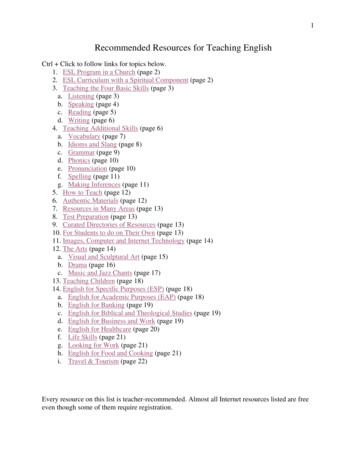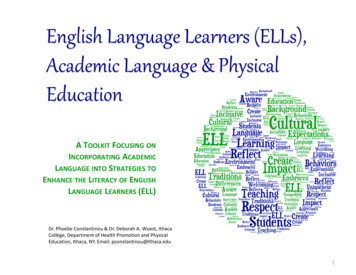
Transcription
English Language Learners (ELLs),Academic Language & PhysicalEducationA TOOLKIT FOCUSING ONINCORPORATING ACADEMICLANGUAGE INTO STRATEGIES TOENHANCE THE LITERACY OF ENGLISHLANGUAGE LEARNERS (ELL)Dr. Phoebe Constantinou & Dr. Deborah A. Wuest, IthacaCollege, Department of Health Promotion and PhysicalEducation, Ithaca, NY. Email: pconstantinou@Ithaca.edu1
IntroductionThe toolkit aims to provide practical yet effective strategiesfor developing academic language skills for all students inphysical education. Another literacy challenge for physicaleducators is helping their English Language Learners(ELLs) to continue their development of English.Therefore, we have included in this toolkit informationabout the stages of language acquisition and theimplications for teaching. In a simple format designed forease of use, this toolkit shows how to explicitly integrateacademic language and language acquisition.Our approach emphasizes the importance of teachers’awareness of their own cultural background and that oftheir students. Teachers should strive to create aninclusive, safe, and welcoming learning environment for allstudents.Lastly, 10 simple, right to the point strategies that can helpyou start revamping your teaching repertoire arepresented.Table of ContentsIntroduction . 2First Things First 3Understanding Academic Language . 4English Language Learners (ELL) 1110 Strategies to Promote English LanguageLearning & Academic Language .20Fitting the Pieces Together . . .31References 322
First Things FirstKnow YourselfKnow Your StudentsKnow What You’re TeachingCreate a Welcoming EnvironmentTake time to reflect on your own culturalbackground. Become aware of any biases orstereotypes that you may hold that may impactyour teaching and your students’ learning.Invest time in learning about students’backgrounds, cultural traditions, language, andexpectations for behaviors with respect toeducation and authorities.Familiarize yourself with the language acquisitionstages, and determine the stage for each of yourELLs. Integrate this information with yourknowledge of academic language and physicaleducation.Be sure to create a warm and welcomingenvironment that is inclusive and respectful, onethat embraces differences and appreciatesuniqueness3
Understanding Academic LanguageThis next section discusses academic language. First,the different tiers of language are presented, withexamples. Next, academic language is defined. Thediscipline-specific academic language of physicaleducation is shown, with examples to highlight thedifferent tiers of language. The various components ofacademic language- vocabulary, language function,syntax and discourse - are presented. As teachers wecan promote the development of academic language byproviding opportunities to speak, listen, read, and write(SLRW) in our classes.Academic language is considered by experts as one ofthe keys to academic success. By planning for thedevelopment of academic language, physical educatorshelp their students acquire one of the critical skills forsuccessful learning in physical education, while satisfyingsome of the Common Core literacy requirements.4
Language TiersLanguage can be conceptualized as consistingof different tiers. Words are categorized into tiersaccording to the frequency and applicability ofthe word.Tier 1 consists of words that are commonly usedon every day speech.Tier 2 consists of words that are used in formalwriting and in academic settings. These wordshave broad applicability and thus can be used invarious disciplines.Tier 3 words have a narrow applicability and arediscipline-specific. Such words lackgeneralization and are mostly used to definespecific vocabulary and concepts of thediscipline.5
Defining Academic LanguageAcademic language is the language students are expected to use in school to acquire a new or deeper understanding ofcontent and to convey that understanding to others. Tier 2 words, that is, general academic vocabulary, are used acrossmany disciplines. Tier 3 words are discipline-specific, and essential to learning within the specific discipline. Both Tier 2 andTier 3 words comprise academic language, along with language function, syntax and discourse.6
Three-Tier Sample WordsTier 2 - GeneralAcademic WordsTier 1 - Everyday WordsTier 3 – DisciplineSpecific WordsVerbsVerbsVerbs erciseRunSkipPassNounsNounsNouns t of viewMusclesTricepsEnduranceMovement7
ContrastDescribeEvaluateAnalyzeSequenceInterpret Sentence structure –simple, compound,complex, orcompound-complex) Sentence length Transitions Verb tenses Active voice Passive voice SpeakingReadingListeningWritingDiscourse Syntax Soccer Penalty kick Free kick Corner kick Goal Kick Throw-in Offside Hand ballLanguage FunctionDiscipline Specific-VocabularyPhysical Education-DisciplineSpecific Academic Language8
We often incorporate languageelements of discourse and syntax intoour physical education classes, withoutrealizing that we do so.Discourse & SyntaxWe need to recognize how weconsciously or incidentally developacademic language. Once we do this,we can increase the opportunities weprovide.ListeningReadingListen anddemonstratecomprehensionby followingdirectionsRead task cardand performtaskExecuting skillusing criticalelementsverballyidentified by theteacherComplete exitslip orworksheetSpeaking WritingList steps in askill as peerperforms orwhen asked bya teacherList critical cueson exit slipGive feedbackto peerAnalyze why astrategy workedusing completesentences9
Meeting Academic courseAcademicLanguage“Being a competent user of academic language means knowing what to say, when to sayit, and how to say it within the different oral and written disciplinary contexts”.(Gottlieb & Ernst-Slavit,2014,p.g 5).10
English Language Learners (ELL)The acquisition of English language is highlighted in thissection. Some general guidelines for physical educatorsto help ELLs to learn are suggested. The five stages oflanguage acquisition are shown. Students proceedthrough these stages at different rates, with a multitudeof factors influencing their progress.SCHOOL BUSNext, for each stage, its characteristics are presented inconjunction with stage-appropriate prompts to elicitstudent use of language. Sample physical educationactivities that teachers can use to help their studentsacquire English are provided along with likely studentactions. This is followed by the academic languagedemands that are appropriate for that specific stage.We hope you will find the sample ideas associated witheach stage helpful in working with your ELLs and providea stepping stone to stimulate your creativity.11
Helpful Ideas to Guide Your Efforts toSupport Language Acquisition with ELLsRecognize, embraceand build on students’native language,literacy, andbackground.Understand andutilize languageacquisition theory.Create a classroomenvironment thatfacilitates all languagelearning.Use visuals andnative tongue wordsto motivate ELLs topractice academiclanguage skills.Recognize languagedevelopment stagesand engage indifferentiatedinstruction andassessmentpractices.12
Stages of Language AcquisitionLanguage acquisition is typically viewed as passing through a series of stages. Eachstage has distinct characteristics.The rate of language acquisition is influenced by a host of factors. Some of the factors,such as opportunities for interaction and collaboration, can easily be incorporated intophysical uency/ExpandingIntermediate duction/Entering13
Selected Factors Influencing the Process ofEnglish Language AcquisitionPreviousEducation Fluency in homelanguage Similarity of homelanguage toEnglishMotivation Support at home Cultural moresInstructionalQuality Instructional support Opportunities to learn Learning environmentPeerInteractions &Role ModelsEnglishLanguageAcquisition Opportunities forinteraction &collaboration Family & friends asmodelsThere are a number of factors influencing the rate of progress of ELLs, only a few of which are presented above. These factors interactwith a host of other factors that influence student learning, Incorporating some of these factors into your teaching can help ELLsdevelop their English skills.14
Word Cards: Discipline-specificvocabulary(dribbling, soccerball, etc.) General academicwords (e.g., and,a, the, she, he,Maria, John, etc.) Students work inpairs Student A- ActivityPicture Task Cardperforms the task Student B- Selectsfrom the correct WordCards (e.g., the words“dribbling”, “is”, “a” and“soccer ball”.Academic Language Demands Appropriate teacherprompts Show me Circle the Where is ? Who has ? Activity Picture TaskCards: e.g., Picture ofchild dribbling asoccer ball orthrowingStudents’ Actions Student takes in thenew language Does not speak it Often betterresponding nonverbally Often lasts six weeksor longerTeacher’s ActionsLanguage CharacteristicsStage 1 - Preproduction or Entering Vocabulary –discipline specificwords (dribbling,throw) Syntax - Studentsneed to put the word inthe correct order (e.g.,Nick is dribbling asoccer ball whencompleting Word Cardactivity15
Students Work inPairs Student A- ActivityPicture Task Cardperforms the task Student B- Selectsfrom the correct WordCards (e.g., thewords “dribbling”, “is”,“a” and “soccer ball”. Wall Sentence Board:Each student writes ashort sentence on theWall Sentence Board(e.g., Angelos isdribbling a soccer ballor she is dribbling thesoccer ball).Academic Language Demands Prompts Yes/no questions Either/or questions Who ? What ? How many ? Activity Picture TaskCards: e.g., picture ofchild dribbling asoccer ball, orthrowing Word Cards: Discipline-specificvocabulary(dribbling, soccerball etc.) General academicwords (e.g., and, a,the, she, he, Maria,John etc.)Students’ Actions Begins to speakusing short wordsand sentences Emphasis is still onlistening andabsorbing the newlanguage Many errorsTeacher’s ActionsLanguage CharacteristicsStage 2 - Early Production orEmerging Vocabulary:Dribbling Discourse: Writing/copying the wordsfrom the Word Cards Syntax- Studentsneed to put the wordin the correct order(e.g., Nick is dribblinga soccer ball).16
PromptsWhy ?How ?Explain In groups of three:Take turns Take an Activity TaskCard read it or look atdiagram again ifneeded. Discuss: Who wouldbe the starter, themiddle passer andshooter for each trial . Perform the task. Wall SentencesBoard: A student withthe help of peerswrites a sentence ortwo with at least onetransition word (e.g.,Angelos dribbled thesoccer ball to point Aand passed the ball toMary.)Academic Language Demands Activity Task Card:With a diagrame.g., In a group ofthree, pass the soccerball to teammates andattempt to shoot at thegoal. Take turns in allthree positions(starter, middle passerand shooter)Students’ Actions Speech is morefrequent Words and sentencesare longer Still relies heavily oncontext clues andfamiliar topics Vocabulary continuesto increase Errors decrease incommon interactionsTeacher’s ActionsLanguage CharacteristicsStage 3 - Speech Emergence/Transitioning Vocabulary: Pass,Shoot Discourse: Readingthe Activity Task Card,discussing (oral) theorder of passing theball to each other.Writing the sentenceson the Wall SentenceBoard Language function:Sequencing theirpasses. Syntax- Writingcomplete sentencewith at least onetransition word (e.g.,Angelos dribbled thesoccer ball to point Aand passed the ball toMary.17
Group of 4 (A, B, C,D designatedstudents) - Eachstudent in the groupmust have a specificrole. For example: Student A- selects theequipment Student B- selects thename of the game Student C- decides ifthe game is safe Student D- decides ifthe game is fair Discuss: Safety andfairnessAcademic Language Demands Prompts Decide if Retell Reads: Activity TaskCards: Using the equipmentprovided create agame that you canplay with your group. Rules: All teammates mustbe included Game must be safeand fair -teacherexplains themeaning of safeand fairStudents’ Actions Speech is fairly fluentin social situations Minimal errors. New contexts andacademic languagestill a challenge Still gaps invocabulary andappropriateTeacher’s ActionsLanguage CharacteristicsStage 4 - Beginning Fluency/Expanding Vocabulary: Safety &Fairness Discourse: Listeningto the teacherinstructions, readingthe Activity Task Card,discussing (oral)safety, fairness, andgame development Language function:Describing (how toplay the game),analyzing (if is safeand fair). Syntax- Aiming tospeak in completesentences18
After creating theirgame, pair-up withanother group. Each group teachestheir game to the othergroup, and all play thegame. Each group offerssuggestions to eachother on how toimprove /modifying thegame for the better.Academic Language Demands Prompts Compare andcontrast. Describe . What are theadvantages of. Pairs-up groups Distributes equipmentneeded for students toplay their createdgames Reads: Activity TaskCards: After pairing-up withthe other group taketurns explaining yourgame and play it.Each student in thegroup must contributeto the explanation(roles assigned tostudents in previouslessons can beassigned here as well)Students’ Actions Communicationbecoming fluent,especially in sociallanguage situations. Almost fluently in newsituations or inacademic areas Still some gaps invocabulary unknownexpressions. Few errors. Higher order thinkingskills possible Offering an opinion oranalyzing a problemTeacher’s ActionsLanguage CharacteristicsStage 5 - Intermediate & Advanced/Commanding Vocabulary: Safety &fairness Discourse: Listeningto the teacherinstructions, readingthe Activity Task Card,discussing (oral) howthe game is played,including the rules,scoring etc. Language function:Describing (how toplay the game),sequencing (thegame) analyzing (if issafe and fair). Syntax- Aiming tospeaking in completesentences19
10 Strategies to Promote English LanguageLearning & Academic LanguageCarefully selected strategies, creative teaching, andpaying attention to students’ needs promote boththe acquisition of English by ELLs and thedevelopment of academic language by all students.Ten strategies for the development of language arepresented in this section. It is suggested thathaving a Communication Center is a strategy thatwould be useful for all students throughout the year.You may find some of the other strategies a betterfit for one unit, one lesson, or perhaps for aparticular group of students.Our best advice is to try one or two strategies at atime, rather than overwhelm yourself trying to do itall. Try a strategy in one class, refine it and make ityour own, and then, when feeling comfortable, useit in other classes.20
Strategy 1 - Communication CenterCommunication CenterSet up a Communication Center with variouscommunication materials. Some suggestionsare blank note cards, paper, an assortment ofwriting tools, and perhaps a tablet with an appthat translates words. Include disciplinespecific and general academic words on cards,pictures of activities, DVDs related to the unit’sactivities, and tablet apps that enable studentsto videotape performance or to demonstratetheir knowledge (e.g., diagraming a strategy).Encourage all students to use theCommunication Center to ease theircommunication with each other and you, theteacher.21
Strategy 2 - Word/Concept of theDayDay 1- Words Reps, Sets Concept CommitmentIdentify the word(s) and concept ofthe day and use the listening,reading, speaking and writingmethod to stimulate learning.Verbally instruct or /read directionsof what needs to be accomplishedfor the day. Have students read thetask cards, station instructions, ortest instructions so that theypractice listening and reading.Have students discuss with theirpeers the concept of the day anduse graphic organizers, journals,short answer questions for a writtentest or verbal discussion toencourage speaking and writing.Fitness UnitDay 2- Words Circuit weight training,Weight lifting Concept PersistenceDay 3- Words Hamstrings, triceps Concept Muscle group22
Strategy 3 - Moving Beyond SpeechBody LanguageVisual aids help ELLscontextualize discipline–specific vocabulary aswell as generalvocabulary.Video ClipsVisual AidsA variety of non-verbalcommunication strategiescan be used to helpstudents understand thetask, modify theirperformance, and/orcomplete an assessment.PicturesDemonstrationsGestures23
Strategy 4 - Experiencing Being the“Other”Video instructions in an unfamiliarlanguage for all students.Let them figure out what is beingsaid and/or what to do with a peer.Students may benefit from being put inthe “shoes” of their ELLs peers. Thesekind of experiences allow students tofeel how it is to be in a setting where youdon’t quite understand what is said orare unsure about what you are expectedto do.The experiences of being the ”other”have been shown to be beneficial indeveloping empathy in others.Video instructions in the language ofthe ELLs.Let the ELLs be the source ofunderstanding .Include games and activities fromother cultures.“Tell me, I'll forget. Show me, I mayremember. But involve me, and I'llunderstand. “-Chinese Proverb24
Strategy 5 - Promote InteractionThe most efficient way to learn alanguage is through humaninteractions.Partners &SmallGroupsPromote interactions by providing opportunities for students to work with partners and in small groups. These opportunitiesencourage ELLs to interact while removing some of the pressures they feel when having to talk in front of a larger group or theentire class.Opportunities to experience success boosts ELL’s self-confidence, which is crucial for acquiring a new language. Partners andpeers can help each other with appropriate vocabulary, spelling, reading, and pronunciation.25
Strategy 6 - Use Assessments toStudents’ AdvantageFormative AssessmentPerformance-basedAssessmentMultiple ResponseOptionsStudent SuccessExperiencesProvides meaningfulinformation for teachersand students.Students demonstratetheir knowledge in amore applicable to lifeway.Use variety of ways tocheck for understandingand gather “evidence” oflearning.Utilize assessment toolsmatching various oflearning styles.Provides moreopportunities for studentsto demonstrate theirknowledge and abilities .Students use theirknowledge/understanding of thesubject to solve realworld problems.Can get a more accuratepicture of what studentsknow and understand.Provide assessmentswith various complexitylevels.Allows teachers tocommunicate feedbackand move learningforward.Helps make connectionsbetween the real worldand classroom.Helps address the needsof diverse students,preferences incommunication style, anddifferent ways ofexpressing knowledge.It builds self-worth asstudents learn toimplement theirknowledge to developskills.Helps teachersdifferentiate instructionand thus improve studentsuccess.Requires higher-orderthinking skills.Supports strugglingstudents and providesroom to challengeadvanced students.Experiencing successleads to increase selfconfidence, motivationand performance.26
Strategy 7 - Teach AcademicLanguage ExplicitlyProvide verbal frames for discussions (e.g.Our defensive strategy is . First . .Then . .Provide summary frames for written work ( e.g., In this .the player .At first . . Then . Finally ).Academic LanguageDemandsHave students read about a sport (e.g.,. newspaper,book, magazine, blog) and summarize it . (e.g., . I foundthe reading .)Have specific daily objectives for academiclanguage.Post transition words in the gymnasiumUse academic language when instructing yourself.Hold students accountable to use complete sentences and correct grammar.27
Strategy 8 - Promote CollaborationCollaborative Learning Ensures Talking and Discussing AmongStudentsListening skillsare developedStrengthens peer relationships and sensitizespeers to difficulties in learning a new languageTalking out louddevelops orallanguage skillsBuilds respectand trustDifferent viewsare questioned& validatedduring discussionUse problemsthat offer theopportunity formultiple solutionsWelcomesdifferences ofopinions/viewsPeers as rolemodels for ELLsDevelop skills inworking togetherto meet groupgoalsStresses personalresponsibility tocontribute to thegroup outcomesOffers more opportunities for ELLto develop languageMore opportunities to uselanguage skills within the groupas each group member’scontribution is expected.Offers a safer environment inwhich to use new language asthere is less pressurecompared to the whole classCollaborative learning is verymuch influenced by theamount and quality ofinteraction.It is critical that as teachers weestablish group roles yet,flexible group norms to allowfor differences in responsesand contributions.Working in small groups allowsELLs more opportunities topractice their language skills ina safe environment.28
Strategy 9 - Incorporate the Student’sNative Tongue and CultureNativeTongue &CultureIntellectuallyEconomicallyHelps the continuationof intellectualdevelopmentProvides better jobopportunitiesSociallyEducationallyHelps maintaincommunity and familyconnectionsSupports higheracademicachievementsPersonallyCritical for student’sidentityWhen needed, allow ELLs to use theCommunication Center to translate key Englishwords to their native tongue so that they mayunderstand the task and/or concepts. Thisfacilitates their learning, boosts their selfconfidence and eases their feeling of being “lost”.Letting students use their native language allowsthem to grow intellectually rather than have theirprogress be limited by the language barriers.Additionally, maintaining fluency in the nativelanguage helps ELL’s sense of identity andassists them in maintaining connections withtheir community and family. Fluency in theirnative tongue may be beneficial for ELLs interms of employment in our increasingly diverseworld and global society.Meaningfully incorporating activities from ELL’snative culture on a consistent basis helps thembe proud of their roots. Including activities fromtheir culture communicates that this culture isvalued. These experiences also broaden otherstudents’ cultural horizons and provides aplatform for promoting acceptance of differences.29
Strategy 10 - Set High, ButReasonable ExpectationsHigh expectations are important for all studentsbut for ELLs this is critical. Many times, lowerexpectations are held for ELLs, indirectly limitingtheir achievement. Similarly, unreachableexpectations could have a backlash effect,discouraging ELLs and affecting their motivationand their self-confidence.High expectationsmove studentsforwardDescribeexpectations clearlyPlan for long- termgoals but focus onshort-termachievementsCelebrate successUse setbacks asteachable momentsAdjust expectationsaccording to thecircumstancesThus, it is important for teachers to be flexibleand to adjust expectations according to theparticular circumstances. Knowing students’capabilities helps teachers provide meaningfulyet challenging opportunities for their growth andsuccess.Use setbacks, in both physical education contentand language skills, as teachable moments tohelp students move forward toward attainingtheir goals. Using both long- and short-termgoals provides opportunities for frequentsuccesses and reassures ELLs that they canlearn.
Fitting the Pieces TogetherPromoting language development within physical education might seem a bit challengingespecially since this is not a traditional expectation of the field. Moreover, add the task ofaddressing ELLs language needs and it further increases the teaching responsibility.Approaching this task with a positive mind set, however, can make a big difference. A numberof popular strategies and approaches that promote language development lend themselves tophysical education. Peer interactions and collaboration are commonly use in physicaleducation and both enhance language development. Holding high expectations for allstudents or using a variety of ways to deliver instruction and assess learning are alsocommon practices among physical education teachers.Some ideas are the use of a Communication Center in conjunction with strategies such as the“Word of the Day’ and focusing on teaching academic language explicitly. Going a bit further,to create a supportive environment for ELLs, you may find it beneficial to occasionally haveyour class experience what it is like to be the “Other”. This usually helps non-ELLs becomemore empathetic to the challenges associated with learning a new language and adapting to anew culture. Be aware of the stage of language acquisition ELLs are at and support them byallowing them to use their native tongue and other methods to enhance their understandingand knowledge.As a teacher, you may find that helping ELLs acquire English and the promotion of academiclanguage are not mutually exclusive. Thoughtful planning, creative teaching, and anappreciation for diversity will help you embrace this challenge and make it a rewardingexperience for both you and the ctionPhysicalEducationSpecificLanguageEnglish Language LearnersLanguage Development WithinPhysical Education31
References32
English Language Acquisition There are a number of factors influencing the rate of progress of ELLs, only a few of which are presented above. These factors interact with a host of other factors that influence student learning, Incorporating some of these factors into your teaching can
